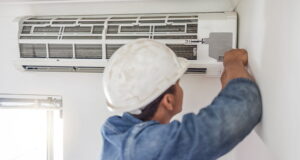How to Improve Ventilation in a Room
Are you tired of dealing with stuffy rooms and lingering odors? Improving the ventilation in your space might just be the breath of fresh air you need! Whether it’s your cozy home office or the bustling living room, ensuring proper airflow can significantly enhance your comfort and health.
From the simple act of opening a window to integrating advanced HVAC systems, there are numerous ways to boost the air quality around you. This article dives into the why and how of enhancing ventilation, offering practical tips and shedding light on the importance of fresh air. So, let’s embark on this journey to create a fresher, healthier environment that not only uplifts your mood but also supports your well-being.
Ready to breathe easier? Keep reading to discover how you can improve ventilation and transform your indoor spaces into havens of fresh air.
What is ventilation?

Ventilation is the process of exchanging or replacing air in any space to provide high indoor air quality. This involves temperature control, removal of moisture, odors, smoke, heat, dust, airborne bacteria, carbon dioxide, and other gases, as well as the replenishment of oxygen. It ensures the delivery of fresh air to an indoor environment and is crucial for creating a safe and comfortable living or working space.
This process can be achieved through natural means, like open windows and vents, or mechanically, using fans and duct systems. Effective ventilation is essential not only for comfort but also for health reasons, as it helps to prevent the buildup of harmful pollutants and contaminants that can lead to respiratory problems and other health issues. Understanding the significance of ventilation involves recognizing its role in maintaining a healthy indoor environment, conserving energy, and ensuring the well-being of occupants by regulating air flow, filtering out pollutants, and controlling humidity levels.
Why improving ventilation is crucial
Improving ventilation is crucial because it directly impacts our health and comfort. By reducing indoor pollutants, controlling humidity, and lowering the risk of respiratory infections, better ventilation creates a safer and more comfortable environment. Indoor pollutants, such as dust, smoke, and volatile organic compounds, can accumulate to harmful levels without adequate ventilation.
These pollutants come from everyday activities and products like cooking, cleaning, or using paint. Controlling humidity is another key reason to improve ventilation. High humidity levels can lead to mold growth and attract pests, both of which pose health risks.
Proper ventilation helps maintain a balanced indoor humidity, preventing these issues. Finally, lowering the risk of respiratory infections is a significant benefit of improved ventilation. Airborne diseases can spread more easily in poorly ventilated spaces.
By ensuring good airflow and reducing the concentration of airborne pathogens, we can protect ourselves and others from illnesses. In summary, enhancing ventilation is essential for maintaining a healthy, comfortable, and safe indoor environment, aligning with the search intent of finding effective HVAC solutions for residential and commercial spaces.
Reduces indoor pollutants
Improving ventilation significantly reduces the concentration of indoor pollutants. This includes dust, smoke, and chemicals from cleaning products.
Types of common indoor pollutants
Common indoor pollutants include volatile organic compounds (VOCs) from paints and furnishings, carbon monoxide from stoves, and particulate matter from burning candles or cooking.
Controls humidity
Effective ventilation controls indoor humidity levels, preventing environments that are too moist or too dry.
Effects of high humidity on health
High humidity can lead to mold growth and dust mites, which are harmful to health, causing allergies and respiratory problems.
Lowers the risk of respiratory infections
By ensuring proper airflow, ventilation lowers the risk of respiratory infections by diluting and removing pathogens from indoor air.
How ventilation reduces airborne diseases
Ventilation reduces airborne diseases by exchanging indoor air with fresh outdoor air, reducing the concentration of airborne pathogens.
Assessing your ventilation system

Assessing your ventilation system is key to ensuring a healthy indoor environment. It involves checking for signs of poor ventilation, such as persistent odors, mold growth, or excessive humidity. Identifying these signs early can help you take corrective action, like cleaning vents or upgrading your system.
Regular maintenance, including cleaning filters and vents, is crucial for optimal performance. By evaluating your ventilation system, you can enhance air quality, improve health, and increase comfort in your home or office. This assessment aligns with the search intent of finding solutions for maintaining or improving HVAC systems to solve residential and commercial HVAC problems.
Identifying signs of poor ventilation
Identifying signs of poor ventilation is crucial for maintaining a healthy indoor environment. Key indicators include:
- Persistent odors do not dissipate, indicating that air is not being effectively refreshed.
- Mold growth on walls or ceilings is a sign of excessive moisture and insufficient air circulation.
- Excessive humidity, which makes the air feel thick and uncomfortable, suggests inadequate ventilation.
- Stale or stuffy air points to the lack of fresh air entering the space.
- Increased allergy symptoms among occupants suggest that allergens are not being adequately removed from the indoor environment.
Recognizing these signs early allows for timely interventions to improve air quality and ensure the comfort and health of everyone in the space.
Natural ventilation strategies
Natural ventilation strategies harness the flow of outdoor air to improve indoor air quality without relying on mechanical systems. By simply opening windows and doors, you can facilitate the natural exchange of indoor and outdoor air. Adopting cross-ventilation techniques, where air enters through one side of the building and exits through the opposite side, effectively removes stale indoor air and introduces fresh air.
Utilizing window fans can enhance this process by directing airflow more efficiently. Moreover, understanding the best times for natural ventilation, such as during cooler parts of the day or when outdoor air quality is high, maximizes the benefits of these strategies. Implementing natural ventilation is a cost-effective way to maintain a healthy and comfortable indoor environment, aligning with the search intent of finding simple and efficient HVAC solutions.
Opening windows and doors
Opening windows and doors is the simplest way to enhance ventilation. This action allows fresh air to flow in and stale air to exit, quickly improving indoor air quality.
Best times for natural ventilation
The best times for natural ventilation are early morning and late evening when the air outside is cooler and fresher. This timing helps in maintaining a comfortable indoor temperature while refreshing the air.
Using window fans
Using window fans can significantly boost air exchange. Positioning a fan in a window blows stale indoor air out and pulls fresh outdoor air in, effectively enhancing the ventilation process.
How to position window fans effectively
To position window fans effectively, place them in windows facing away from the prevailing wind on the leeward side of the home. This setup helps create a stronger draft through the house.
Implementing cross-ventilation
Implementing cross-ventilation involves opening windows or doors across a room or building to create a breeze that carries fresh air through the space, making it more comfortable and reducing the need for air conditioning.
Identifying optimal cross-ventilation paths
Identifying optimal cross-ventilation paths requires understanding the layout of your space and the direction of prevailing winds. Openings should be positioned to allow air to flow directly across a room, with paths unobstructed by furniture or other barriers.
Mechanical ventilation strategies
Mechanical ventilation strategies involve using devices and systems to enhance indoor air quality and comfort. Installing exhaust fans in key areas like bathrooms and kitchens helps remove odors, moisture, and pollutants directly from their source. Air purifiers play a crucial role in filtering out particles and improving overall air quality.
For a more comprehensive solution, integrating HVAC systems with fresh air intake ensures a constant supply of clean air, balancing indoor temperature and humidity levels. These strategies are vital for environments where natural ventilation is limited or insufficient, providing a controlled and effective way to maintain a healthy indoor atmosphere. Adopting mechanical ventilation aligns with the search intent of finding advanced HVAC solutions to address residential and commercial air quality challenges.
Installing exhaust fans
Installing exhaust fans is essential in removing excess moisture, odors, and pollutants from specific areas within a building, ensuring a healthier indoor environment.
Key locations for exhaust fans
The key locations for exhaust fans include bathrooms and kitchens, where moisture and odors are most prevalent, to prevent mold growth and eliminate cooking smells.
Using air purifiers
Using air purifiers helps filter out dust, pollen, and other airborne particles, significantly improving indoor air quality for a more comfortable living space.
Choosing the right air purifier
Choosing the right air purifier depends on the size of the room and the specific needs, such as allergen removal or smoke elimination, ensuring the device effectively cleans the indoor air.
Integrating HVAC systems
Integrating HVAC systems with proper ventilation mechanisms allows for a comprehensive approach to maintaining indoor air quality, temperature, and humidity at optimal levels.
Advantages of HVAC with fresh air intake
The advantages of HVAC with fresh air intake include a constant supply of fresh outdoor air, reduced indoor pollutants, and improved overall air quality, contributing to healthier and more comfortable indoor environments.
Enhancing ventilation with plants
Enhancing ventilation with plants is a natural and effective way to improve indoor air quality. Plants like the Spider Plant, Snake Plant, and Peace Lily have been shown to absorb pollutants and release oxygen, contributing to cleaner and fresher indoor air. Incorporating these air-purifying plants into your home or office not only boosts the aesthetic appeal but also enhances the overall wellness of the environment.
This green strategy complements mechanical and natural ventilation methods, providing a holistic approach to maintaining a healthy indoor atmosphere. Adopting plants as part of your ventilation strategy aligns with the search intent of finding eco-friendly and sustainable HVAC solutions.
Types of air-purifying plants
Air-purifying plants are a natural way to enhance indoor air quality. These plants absorb common indoor pollutants while releasing oxygen, making the air in your home or office cleaner and fresher.
Spider Plant, Snake Plant, and Peace Lily
- Spider Plant: Known for its ability to remove harmful toxins from the air, the Spider Plant is also easy to maintain, making it a popular choice for indoor spaces.
- Snake Plant: Also known as Mother-in-Law’s Tongue, the Snake Plant is highly efficient at filtering indoor air and can thrive in low-light conditions.
- Peace Lily: This plant not only beautifies the space but also purifies the air by absorbing mold spores and other pollutants, contributing to a healthier indoor environment.
Together, these plants offer a simple and effective way to improve indoor air quality naturally.
Maintaining optimal ventilation
Maintaining optimal ventilation is crucial for ensuring a healthy and comfortable indoor environment. This involves regular cleaning of vents and filters to prevent dust and pollutants from circulating. Additionally, scheduling regular maintenance for your HVAC system ensures that it operates efficiently, effectively managing air flow and quality throughout your space.
Monitoring indoor air quality is also essential, as it helps identify areas for improvement, allowing for timely adjustments to your ventilation strategy. By adhering to these practices, you can sustain a level of ventilation that supports well-being and comfort for all occupants, aligning with the search intent of achieving and maintaining high-quality indoor air through practical HVAC solutions.
Cleaning vents and filters
Regular cleaning of vents and filters is essential to remove dust, allergens, and other pollutants, ensuring the air circulating in your space is clean. This not only improves air quality but also enhances the efficiency of your ventilation system.
Schedule for regular maintenance
Establishing a schedule for regular maintenance of your HVAC system is crucial for its optimal performance. Routine checks can prevent unexpected breakdowns, ensuring your system effectively manages airflow and maintains indoor air quality year-round.
Monitoring indoor air quality
Monitoring indoor air quality is key to identifying potential issues and making necessary adjustments to your ventilation strategy. Utilizing air quality monitors can help track levels of pollutants and humidity, allowing for timely interventions to maintain a healthy indoor environment.
Improve Ventilation with Callidus Air
Improving ventilation with Callidus Air means partnering with experts dedicated to enhancing the air quality of your home or business. Callidus Air specializes in providing tailored HVAC solutions, from installing advanced air purification systems to optimizing natural and mechanical ventilation strategies. Our team conducts thorough assessments to identify specific needs, ensuring your space benefits from the most effective ventilation improvements.
With Callidus Air, you gain access to the latest technology and industry insights, ensuring your environment is not only comfortable but also supports the well-being of all occupants. Trust Callidus Air to elevate your indoor air quality, aligning with the search intent for professional, efficient HVAC solutions.
Final Thoughts
Ensuring optimal ventilation in your home or business is not just about comfort; it’s a crucial aspect of maintaining a healthy environment. From natural strategies like opening windows to mechanical solutions such as installing air purifiers, each method plays a vital role in enhancing indoor air quality. Regular maintenance and monitoring are key to sustaining these benefits over time.
Whether you’re looking to improve your existing system or seeking advanced HVAC solutions, remember that the goal is to create a space that supports the well-being of everyone inside. Embrace the journey towards better air quality with the understanding that every step taken is a step towards healthier living and working environments.

